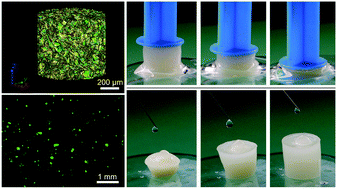Chondrogenic potential of macroporous biodegradable cryogels based on synthetic poly(α-amino acids)†
Abstract
In this study, the potential of highly porous hydrogels based on biodegradable synthetic poly(α-amino acids) to support proliferation and chondrogenesis of human dental pulp stem cells (hDPSCs) was investigated. Covalently crosslinked gels with permanent pores were formed under cryogenic conditions by free-radical copolymerization of poly[N5-(2-hydroxyethyl)-L-glutamine-stat-N5-(2-methacryloyl-oxy-ethyl)-L-glutamine] (PHEG-MA) with 2-hydroxyethyl methacrylate (HEMA) and N-propargyl methacrylamide (PrMAAm) as minor co-monomers. PrMAAm provided alkyne groups for modifying the gels with cell-supporting moieties (RGDS peptides) by the azide–alkyne “click”-reaction. Two types of gels with different compressive moduli were prepared. Each type was modified with two different concentrations of RGDS peptide. X-ray computed nanotomography (nanoCT) was used to visualize and analyze the 3D-structure of the cryogels. It was shown that modifying the PHEG-MA cryogels within the range of RGDS concentrations examined here had a positive effect on the proliferation of hDPSCs. Immunofluorescence staining for collagen type 2 and aggrecan proved that there was differentiation of hDPSCs into chondrocytes.



 Please wait while we load your content...
Please wait while we load your content...